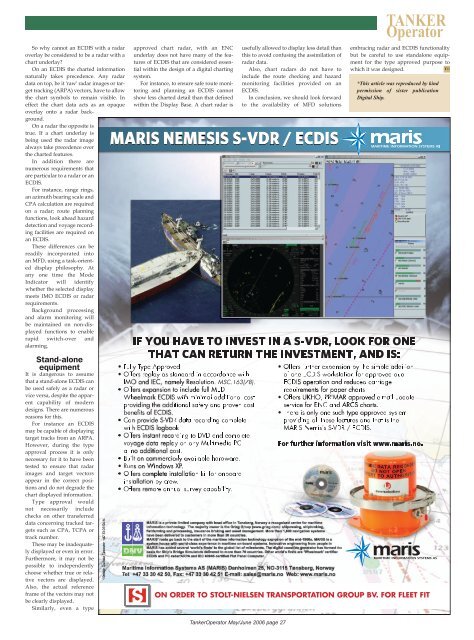Navigation standards slammed - Tanker Operator
Navigation standards slammed - Tanker Operator
Navigation standards slammed - Tanker Operator
Create successful ePaper yourself
Turn your PDF publications into a flip-book with our unique Google optimized e-Paper software.
p26-29.qxd 09/05/2006 11:26 Page 2<br />
TANKER<br />
<strong>Operator</strong><br />
So why cannot an ECDIS with a radar<br />
overlay be considered to be a radar with a<br />
chart underlay?<br />
On an ECDIS the charted information<br />
naturally takes precedence. Any radar<br />
data on top, be it 'raw' radar images or target<br />
tracking (ARPA) vectors, have to allow<br />
the chart symbols to remain visible. In<br />
effect the chart data acts as an opaque<br />
overlay onto a radar background.<br />
On a radar the opposite is<br />
true. If a chart underlay is<br />
being used the radar image<br />
always take precedence over<br />
the charted features.<br />
In addition there are<br />
numerous requirements that<br />
are particular to a radar or an<br />
ECDIS.<br />
For instance, range rings,<br />
an azimuth bearing scale and<br />
CPA calculation are required<br />
on a radar; route planning<br />
functions, look ahead hazard<br />
detection and voyage recording<br />
facilities are required on<br />
an ECDIS.<br />
These differences can be<br />
readily incorporated into<br />
an MFD, using a task-oriented<br />
display philosophy. At<br />
any one time the Mode<br />
Indicator will identify<br />
whether the selected display<br />
meets IMO ECDIS or radar<br />
requirements.<br />
Background processing<br />
and alarm monitoring will<br />
be maintained on non-displayed<br />
functions to enable<br />
rapid switch-over and<br />
alarming.<br />
approved chart radar, with an ENC<br />
underlay does not have many of the features<br />
of ECDIS that are considered essential<br />
within the design of a digital charting<br />
system.<br />
For instance, to ensure safe route monitoring<br />
and planning an ECDIS cannot<br />
show less charted detail than that defined<br />
within the Display Base. A chart radar is<br />
usefully allowed to display less detail than<br />
this to avoid confusing the assimilation of<br />
radar data.<br />
Also, chart radars do not have to<br />
include the route checking and hazard<br />
monitoring facilities provided on an<br />
ECDIS.<br />
In conclusion, we should look forward<br />
to the availability of MFD solutions<br />
embracing radar and ECDIS functionality<br />
but be careful to use standalone equipment<br />
for the type approved purpose to<br />
which it was designed.<br />
TO<br />
*This article was reproduced by kind<br />
permission of sister publication<br />
Digital Ship.<br />
Stand-alone<br />
equipment<br />
It is dangerous to assume<br />
that a stand-alone ECDIS can<br />
be used safely as a radar or<br />
vice versa, despite the apparent<br />
capability of modern<br />
designs. There are numerous<br />
reasons for this.<br />
For instance an ECDIS<br />
may be capable of displaying<br />
target tracks from an ARPA.<br />
However, during the type<br />
approval process it is only<br />
necessary for it to have been<br />
tested to ensure that radar<br />
images and target vectors<br />
appear in the correct positions<br />
and do not degrade the<br />
chart displayed information.<br />
Type approval would<br />
not necessarily include<br />
checks on other transferred<br />
data concerning tracked targets<br />
such as CPA, TCPA or<br />
track number.<br />
These may be inadequately<br />
displayed or even in error.<br />
Furthermore, it may not be<br />
possible to independently<br />
choose whether true or relative<br />
vectors are displayed.<br />
Also, the actual reference<br />
frame of the vectors may not<br />
be clearly displayed.<br />
Similarly, even a type<br />
<strong>Tanker</strong><strong>Operator</strong> May/June 2006 page 27
















